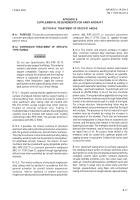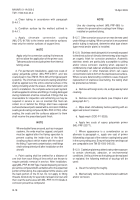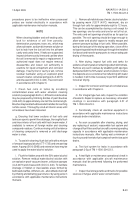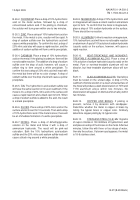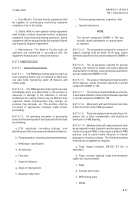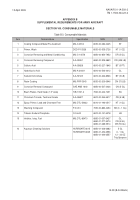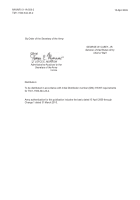TM-1-1500-344-23-2 - Page 229 of 240
NAVAIR 01-1A-509-2
TM 1-1500-344-23-2
15 April 2009
B-26.2. CHROMIUM. Place a drop of 10% hydrochloric
acid on the metal surface, followed by a drop of
concentrated sulfuric acid. If the plating is chromium,
the solution will turn green within one to two minutes.
B-26.3. ZINC. Place a drop of 10% hydrochloric acid on
the metal. If the metal is zinc, reaction will be rapid. A
drop of sodium sulfide over the hydrochloric acid will
cause a white precipitate. To confirm this test, a drop of
20% nitric acid also will cause a rapid reaction, and the
addition of sodium sulfide will form a white precipitate.
B-26.4. CADMIUM. Place a drop of 10% hydrochloric
acid on the metal. If the plating is cadmium, there will be
no noticeable reaction. The addition of a drop of sodium
sulfide over the drop of acid; however, will cause a
yellow ring to form around a white precipitate. To
confirm this test a drop of 20% nitric acid will react with
the metal but there will be no color change. A drop of
sodium sulfide over the drop of acid will cause a yellow
precipitate.
B-26.5. TIN. The hydrochloric acid-sodium sulfide test
will have the same reaction on tin as on cadmium. If the
metal is tin, a drop of 20% nitric acid on the surface will
cause a rapid reaction and a black spot to form. When
a drop of sodium sulfide is added to the acid, the result
is a black precipitate.
B-26.6. SILVER. Place a drop of 20% nitric acid on the
surface and let it react for 10 seconds. Then add a drop
of 10% hydrochloric acid. If the metal is silver, there will
be an immediate formation of a white precipitate.
B-26.7. NICKEL. Place a drop of dimethylglyoxime
solution on the metal and follow it with a drop of
ammonium hydroxide. The result will be pink-red
coloration. Both the 10% hydrochloric acid-sodium
sulfide and the 20% nitric acid-sodium sulfide tests will
cause a black ring around a white precipitate.
B-26.8. MAGNESIUM. A drop of 10% hydrochloric acid
on magnesium will cause a violent reaction and a black
spot to form. To confirm that the metal is magnesium,
place a drop of 10% sodium hydroxide on the surface.
There should be no reaction.
B-26.9. ALUMINUM. Unlike its reaction on magnesium,
10% hydrochloric acid will have no noticeable reaction
on aluminum. A spot of 10% solution of sodium hydroxide
(caustic soda) on the surface, however, will cause a
rapid reaction.
B-26.10.
HEAT-TREATABLE AND NONHEAT-
TREATABLE ALUMINUM ALLOYS. Place a drop of
10% solution of sodium hydroxide (caustic soda) on the
metal. Pure or nonheat-treatable aluminum will not
discolor, but heat-treatable aluminum alloys will turn
black.
B-26.11.
CLAD ALUMINUM ALLOYS. Clad alloys
must be tested on the unclad edge. A drop of 10%
cadmium chloride solution on a clean unclad surface of
the metal will produce a dark discoloration on 7076 and
7178 aluminum alloys within two minutes. No
discoloration will appear on 2024 aluminum alloy within
two minutes.
B-26.12.
COPPER AND BRASS. If plating is
present, remove it by abrasion with sandpaper.
Determine whether the metal is copper or brass by
noting the typical brass or copper color. Similarly
determine copper plating by its typical color.
B-26.13.
STAINLESS STEEL (18-8). Mix 10 grams
of cupric chloride in 100 milliliters of hydrochloric acid
and place one drop of the mixture on the metal. After two
minutes, follow this with three or four drops of water,
then dry the surface. If a brown spot appears, the metal
is 18-8 stainless steel.
B-27/(B-28 Blank)
Back to Top

